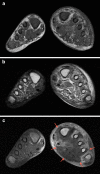Imaging findings of ecthyma gangrenosum, an unusual complication of pseudomonas sepsis
- PMID: 23024626
- PMCID: PMC3192886
- DOI: 10.1007/s11420-011-9216-1
Imaging findings of ecthyma gangrenosum, an unusual complication of pseudomonas sepsis
Abstract
A child with acute lymphoblastic leukemia and pseudomonas sepsis rapidly developed left foot pain and swelling. A diagnosis of ecthyma gangrenosum was made. The clinical and imaging features of this unusual entity are discussed. To our knowledge, this is the first description of the MR imaging findings of ecthyma gangrenosum.
Keywords: MRI; ecthyma gangrenosum; pediatric; pseudomonas.
Figures


References
-
- Fuchshuber PR, Lipman B, Kraybill WG, Gibbs JF. Ecthyma gangrenosum secondary to E. coli sepsis. Infect Med. 1998;15:798–801.
Publication types
LinkOut - more resources
Full Text Sources

